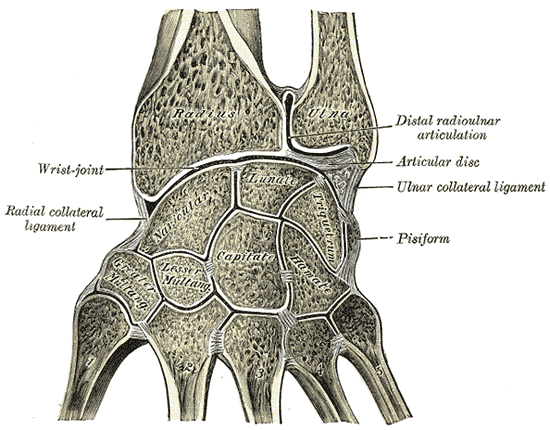Any answer to why you have two bones in your forearm (and lower leg) would simply be conjecture, but it’s helpful to consider the rationale.
Start at the wrist.

Frontal cross-section of the wrist joint.
As the picture above shows, the radius hangs a little lower than the ulna. So when you place your palm on the ground, as you would for a push up, the ground sends most of its force up through the radius. But if we follow it up to the elbow, we see that the ulna is the main bony connection to the upper arm. That is, there’s a gap between the radius and humerus.
What gives?
Those anatomy books that you have to buy for your classes are super helpful. Gilroy’s is my favorite. It’s beautifully illustrated. Learning anatomy is much easier when you have great visuals.
The problem is that they’re misleading to those who have never looked at a cadaver. When you’re examining at an actual body, everything looks the same. Every tissue is pink.
You think veins are actually blue? Pink.
Nerves are yellow? Pink.
Parietal cortex is green? Frontal cortex is red? Occipital cortex is blue? Pink.
So looking at these books makes it easy to get lost in simple solutions. Maybe you have a picture of just pronator teres in your book. It’s easy to get stuck into thinking pronator teres is going to do everything.
The interosseous membrane seems to get lost in discussion since it isn’t contractile like your traditional muscles. But this tissue is huge when we look at both bones of the lower extremity.
Going back to our push up forces travelling up the radius, what happens next? The radius pulls the interosseous membrane which pulls the ulna superiorly. Now we have forces transmitted through the ulna, which go to the humerus, then to the scapula…
This way, forces are dispersed. Similar things happen when we contract our elbow flexors, which mostly connect to the radius. They pull the radius, which pulls the interosseous membrane, which pulls the ulna… Without this, it would be much easier to overuse the humeroradial joint.
This point is illustrated everywhere you can find an overuse injury. Runners get iliotibial band syndrome. Tennis players get lateral epicondylitis. People who work on their feet get plantar fasciitis.
Don’t keep all your eggs in one basket. The simple fix is to spread the load and stop asking the little guy to handle it all.

Add some color to this commentary.